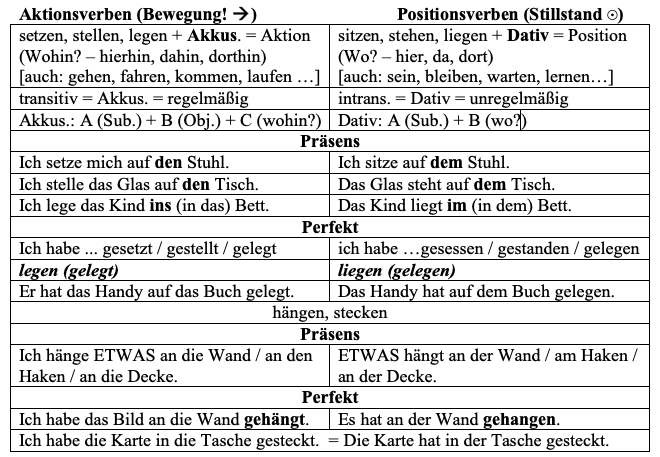We use the verbs liegen and legen very often. They have a related meaning but they express 2 opposed aspects. Since many German students struggle to distinguish them, I’m going to explain the difference in this post.
1. Position versus Action
Liegen and legen refer both to “flat on a surface”. But legen means “to place/put something down flat (= lay)”. Thus, it always expresses an action and needs a direct object (= the thing being placed on a surface). Example: Ich lege das Messer (direct object) auf den Tisch.
We use it also for people, normally as a reflexive verb: sich ins Bett/auf den Boden legen (to go to bed/lay oneself down on the floor). Example: Jaime hat sich ins Bett gelegt. Legen is a regular verb (ich legte, ich habe gelegt).
Liegen, however, refers to the position: “to be in a flat/horizontal position on a surface (= lie)”. So, there can never be a direct object. Example: Das Messer liegt auf dem Tisch.
Liegen has also the meaning “to be located somewhere (in a country)”: Spanien liegt in Europa. Liegen is an irregular verb (ich lag, ich habe/bin gelegen⚠️).
We could say the position is the result of the action (I place/put the knife on the table [action]. ➜ Now it is on the table [position].). The important basic fact is their common meaning “flat on a surface”. So, we use it only with things that cannot – or usually do not – stand: pen(cil)s, keys, papers, fruit, clothes, etc.
2. Other Verbs with the Same Distinction
Exactly the same happens with 2 other pairs of verbs: setzen vs. sitzen, stellen vs. stehen. The first verb of both pairs refers to the action. Examples:
- Ich setze mich auf den Stuhl.
- Die Lehrerin stellt sich vor die Tafel.
The second verb, on the contrary, refers to the position (after the object has been placed or the person has placed themself there). Examples:
- Ich sitze auf dem Stuhl.
- Die Lehrerin steht vor der Tafel.
Special case hängen: This verb has both meanings in present tense (with object: “I hang a picture on the wall” and without object: “The picture is hanging on the wall”). But in Perfekt and Präteritum it has 2 different conjugations depending on the use with object (hängt, habe gehängt) or without object (hing, hat gehangen). I wrote a post about this topic.
3. Wechselpräpositionen
All these verbs mentioned in this post normally have a 2-way preposition (Wechselpräposition) after them: in, an, über, auf, unter, vor, hinter, neben, zwischen. This means we have to combine:
- The verbs of action (setzen, stellen, legen, hängen) + direct object in AKKUSATIV (= the thing being moved) + Wechselpräposition with AKKUSATIV (answers to the question WOHIN?) ➜ Someone (A=subject) puts a thing (B=direct object) somewhere (C=prepositional phrase).
- The verbs of position (sitzen, stehen, liegen, hängen) + Wechselpräposition with DATIV (answers to the question WO?) ➜ A thing (A=subject) is somewhere (B=prepositional phrase).
Here is a summary of this post in a practical table:



